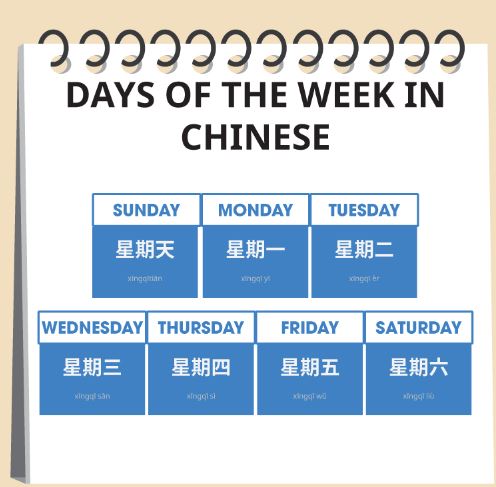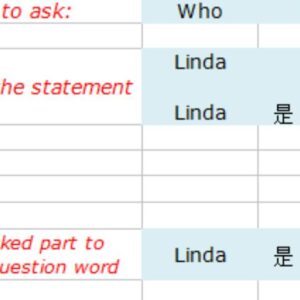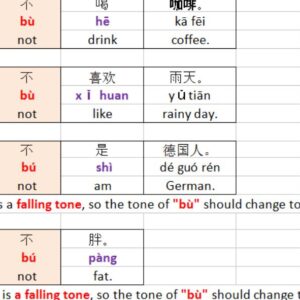Whether you intend to arrange meetings, make vacation appointments, or strategy social tasks, you more than likely won’t have the ability to achieve that without understanding just how to claim dates in Chinese.
Days in Chinese work quite in different ways than in English. To begin with, they follow a various word order. However do not worry, Chinese can be simpler because there’s just one means to say the date– not numerous ways as there remain in English. And also there’s a basic formula to adhere to. When you obtain the pattern down, you’ll have the ability to state the date in Chinese in no time.
This guide will certainly provide you a total insight right into all the different elements of the day in Chinese– year, month, day. You’ll discover just how to state the date in the complete type and shortened form, and also create the date in Chinese like a regional.
Allow’s have a look!

How to Say Dates in Mandarin Chinese
In Chinese, dates are called “日期 (rìqī)”. To say the date in Chinese, you have to not only know your numbers but also be able to pronounce the years, months, and days correctly. Then there are some important differences between how dates are said in Chinese and other languages such as English and Spanish.
Before we delve into the details, let’s look at a few things you need to be aware of when learning this aspect of the Chinese language.
Key Vocabulary for Dates in Chinese
First of all, to say and write dates in Chinese, you’ll need to know three keywords.
| English | Character | Pinyin |
| year | 年 | nián |
| month | 月 | yuè |
| date | 号 | hào |
These words are the building blocks of the date expression in Chinese. You’ll use them for every date.
Numbers for Dates in Chinese
In English, ordinal numbers (such as “first” or “second”) are used to say the date. In Chinese, however, you always use cardinal numbers. To say the date and month in Chinese, you’ll need to know the words for all the numbers from one to thirty-one.
If you have a bit of a knack for Chinese numbers, the dates should pose no particular problem for you. We’ve written a complete tutorial on numbers in Chinese to help you get started.
If you are not comfortable with the Chinese number system yet, try practicing it with random strings of numbers rather than counting in order. This proves to be a far more effective way to remember numbers in Chinese. You can also post notes around your house with the Arabic numeral and the Chinese word for that number. Soon you’ll get used to associating the two.
Formula for Saying the Date in Chinese
When you say the date in Chinese, you’ll use a different form than you may have learned in English. One of the most important things to note is that in Chinese, the year comes first, followed by the month and then the day.

For saying the date in its entity, you use a simple formula:
- 年 (nián) + 月 (yuè) + 日 (rì)
When you announce a date of the current year, you’d commonly leave out announcing the year.
- 月 (yuè) + 日 (rì)
That being said, you are now ready to learn how to say the date in Chinese!
Years in Chinese
The first step to saying the date in Chinese is to say the year.
Unlike in many languages where you express the year by saying the whole number (e.g. 2021 in Spanish – dos mil veintiuno), to say the year in Chinese, you read out each digit of the number, and then add the word 年 (nián) – “year” to it.
For example,
- 1990[年]: 一九九零[年] (yī jiǔ jiǔ líng [nián])
- 2008[年]: 二零零八[年] (èr líng líng bā [nián])
- 2019[年]: 二零一九[年] (èr líng yī jiǔ [nián])
- 1976[年]: 一九七六[年] (yī jiǔ qī liù [nián])
- 2020[年]: 二零二零[年] (èr líng èr líng [nián])
A common mistake people make when saying the year in Chinese would be splitting the number the English way (e.g. 2020 – twenty twenty).
- Don’t say: 二十二十年 (èr shí èr shí nián), 十九九十八年 (shí jiǔ jiǔ shí bā nián), etc
- Do say: 二零二零年 (èr líng èr líng nián), 一九九八年 (yī jiǔ jiǔ bā nián)
If you’re talking about a recent year, you can also use a shortened way of expressing years by just reading out the last two digits of the number, like
- 二零年
èr líng nián
the year 2020
Literally, “two zero year”
- 八八年
bā bā nián
the year 1988
Literally, “eight eight year”
Theoretically, the two digits can refer to all those “20”s and “88”s in different centuries, but as long as the context is clear, people won’t be confused by the shortened version. For instance, if you say you were born in the year 88 – 八八年 (bā bā nián), people will surely know you are talking about 1988, not 1888 or 1788. (unless you’re a vampire!)
Last but not least, don’t get the two-digit shortened version mixed up with the way of saying whole numbers in Chinese. If you pronounced the year (19)88 as 八十八年 (bā shí bā nián), it would instead mean “eighty-eight years”. So, always read out each digit!
In most instances, you probably won’t need to state the year along with the date if you’re just speaking conversationally. But if you do, make sure to say the year at the very beginning rather than at the end.
Months in Chinese
After saying the year, you’ll then say the month of the year.
Here are twelve months in Chinese with the pronunciation.

| English | Chinese | Pinyin |
| January | 一月 | yī yuè |
| February | 二月 | èr yuè |
| March | 三月 | sān yuè |
| April | 四月 | sì yuè |
| May | 五月 | wǔ yuè |
| June | 六月 | liù yuè |
| July | 七月 | qī yuè |
| August | 八月 | bā yuè |
| September | 九月 | jiǔ yuè |
| October | 十月 | shí yuè |
| November | 十一月 | shí yī yuè |
| December | 十二月 | shí èr yuè |
The names for the months in Chinese are based on the word 月 (yuè), meaning “month” and a simple numerical sequence. To say January through December, start with the number that corresponds to the month and then follow it up 月 (yuè).
January is thus 一月 (yī yuè) – the first month, February is 二月 (èr yuè) – the second month, and so on all the way up to December 十二月 (shí èr yuè) – the twelfth month.
Once you’ve learned how to count to 12 in Chinese, saying the month should just be intuitive. If you still have a problem associating the numbers with the month names, buy a Chinese calendar so you’re looking at them regularly.
Days of the Month in Chinese
Finally, you’ll say the day of the month to round out the date.
Here’s how you say the 31 days of the month in Chinese.
| English | Chinese | Pinyin |
| 1st | 一号 | yī hào |
| 2nd | 二号 | èr hào |
| 3rd | 三号 | sān hào |
| 4th | 四号 | sì hào |
| 5th | 五号 | wǔ hào |
| 6th | 六号 | liù hào |
| 7th | 七号 | qī hào |
| 8th | 八号 | bā hào |
| 9th | 九号 | jiǔ hào |
| 10th | 十号 | shí hào |
| 11th | 十一号 | shí yī hào |
| 12th | 十二号 | shí èr hào |
| 13th | 十三号 | shí sān hào |
| 14th | 十四号 | shí sì hào |
| 15th | 十五号 | shí wǔ hào |
| 16th | 十六号 | shí liù hào |
| 17th | 十七号 | shí qī hào |
| 18th | 十八号 | shí bā hào |
| 19th | 十九号 | shí jiǔ hào |
| 20th | 二十号 | èr shí hào |
| 21st | 二十一号 | èr shí yī hào |
| 22nd | 二十二号 | èr shí èr hào |
| 23rd | 二十三号 | èr shí sān hào |
| 24th | 二十四号 | èr shí sì hào |
| 25th | 二十五号 | èr shí wǔ hào |
| 26th | 二十六号 | èr shí liù hào |
| 27th | 二十七号 | èr shí qī hào |
| 28th | 二十八号 | èr shí bā hào |
| 29th | 二十九号 | èr shí jiǔ hào |
| 30th | 三十号 | sān shí hào |
| 31st | 三十一号 | sān shí yī hào |
Dates in Chinese follow the same pattern of months: you’ll say the number of the day first, then follow it up with the word 号 (hào), meaning “date”.
As with months, you use cardinal numbers (one, two, three, etc) instead of ordinal numbers (first, second, third, etc) for dates in Chinese, e.g. 三号 (sān hào), not 第三号 (dì sān hào).
How to Say the Days of the Week

In Chinese: 周一 / 礼拜一 / 星期一
Pinyin: zhōu yī / lǐ bài yī / xīng qī yī
In English: Monday
In Chinese: 周二 / 礼拜二 / 星期二
Pinyin: zhōu èr / lǐ bài èr / xīng qī èr
In English: Tuesday
In Chinese: 周三 / 礼拜三 / 星期三
Pinyin: zhōu sān / lǐ bài sān / xīng qī sān
In English: Wednesday
In Chinese: 周四 / 礼拜四 / 星期四
Pinyin: zhōu sì / lǐ bài sì / xīng qī sì
In English: Thursday
In Chinese: 周五 / 礼拜五 / 星期五
Pinyin: zhōu wǔ / lǐ bài wǔ / xīng qī wǔ
In English: Friday
In Chinese: 周六 / 礼拜六 / 星期六
Pinyin: zhōu liù / lǐ bài liù / xīng qī liù
In English: Saturday
In Chinese: 周日 /礼拜天 / 礼拜日 / 星期日 /星期天
Pinyin: zhōu rì / lǐ bài tiān / lǐ bài rì / xīng qī rì / xīng qī tiān
In English: Sunday
Dates in Chinese – The Complete Form
Now that you know the years, months, and days in Chinese, we can put all the pieces together to say the entire date using the “年 (nián) + 月 (yuè) + 日 (rì)” formula.
Here are some examples:
- December 25, 2021
二零二一年十二月二十五号
èr líng èr yī nián shí èr yuè èr shí wǔ hào
Literally, “two zero two one year, twelve month, twenty-five date”
- February 14, 1986
一九八六年二月十四号
yī jiǔ bā liù nián èr yuè shí sì hào
Literally, “one nine eight six year, two month, fourteen date”
- July 4, 1776
一七七六年七月四号
yī qī qī liù nián qī yuè sì hào
Literally, “one seven seven six year, seven month, four date”
You can also say the year in the two-digit shortened way if it is recent and the context is clear.
For instance,
- 我出生在八六年二月十四号。
Wǒ chūshēng zài bā liù nián èr yuè shí sì hào.
I was born on February 14, (19)86.
Easy, isn’t it?
Just one note: there is a slightly more formal way of expressing the date of the month by using 日 (rì) instead of 号 (hào).
- December 25, 2021
二零二一年十二月二十五日
èr líng èr yī nián shí èr yuè èr shí wǔ rì
- February 14, 1986
一九八六年二月十四日
yī jiǔ bā liù nián èr yuè shí sì rì
- July 4, 1776
一七七六年七月四日
yī qī qī liù nián qī yuè sì rì
The word 日 (rì) means “day”. It works the same way as 号 (hào) when constituting the date in Chinese (you add it after the number of the day) – but it’s less common in daily use (you’ll encounter this word mainly in formal contexts such as documents and news reports).
So, stick to 号 (hào) in your daily Chinese interaction – it sounds more normal.
How to Ask the Date in Chinese
There are two main ways to ask about the date in Chinese.
今天几号?(Jīntiān jǐ hào?)
The most common and natural way to ask for the date in Chinese is to use the question 今天几号?(Jīntiān jǐ hào?)
The word 几 (jǐ) is the question word for asking a specific number. So this question literally means “today (is) what number date?”.
And when you are asked the date, you could answer by saying 今天是 (jīntiān shì) – meaning “today is” before the date. For example, when someone asked you “今天几号 (jīntiān jǐ hào)?”, you could say,
- 今天是七月七号。
Jīntiān shì qī yuè qī hào.
Today is September 7.
And in most contexts, you can reply with just the date (day of the month).
- 今天是七号。
Jīntiān shì qī hào.
Today is the 7th.
The verb “be” – 是 (shì) in 今天是 (jīntiān shì) is optional and often omitted in spoken Chinese. It’s totally okay to say 今天七月七号 (Jīntiān qī yuè qī hào), 今天七号 (Jīntiān qī hào), etc.
今天几月几号?(Jīntiān jǐ yuè jǐ hào?)
You can also ask 今天几月几号?(Jīntiān jǐ yuè jǐ hào?)
You typically use this question, which is translated as “today what number month what number date” word for word when you want to know what the month is as well as the date. People will then give you the number of both the month and the day, like
- 今天三月十五号。
Jīntiān sān yuè shí wǔ hào.
Today is March 15.
If you want to know what day of the week it is instead of the specific date, use the phrase 今天星期几? (Jīntiān xīngqī jǐ?). This question means “what day is it today?” and people will respond with a day of the week. There are other ways to ask for the same information.
When you give the date for the current year in an informal style, it’s normal to omit the year.
- 今天是九月十号。
Jīntiān shì jiǔ yuè shí hào.
Today is September 10.
For the same reason, you wouldn’t normally ask for the year when asking the date. But if you happened to wake up from a coma and were wondering what year it was, you could ask 现在是几几年 (Xiànzài shì jǐ jǐ nián?), which means “what year is it now?”.
Remember to say 几 (jǐ) twice as each 几 (jǐ) corresponds to one digit in the two-digit version of saying the year.
How to Write the Date in Chinese
There are three ways to write the date in Chinese. There is the numerals-only version, the characters-only version, and a mix of numerals and characters. Let’s take a look at how to write the date using each method!
Only Numerals
Like the rest of the world, Chinese people use Arabic numerals widely in daily life. It’s possible to write the date in Chinese without resorting to characters.
But be careful!
To write the date using only numerals, you’ll always write the numerals corresponding to the year first, followed by the month and then the day, which reverses the British style of putting the day first. The numerals can be separated by slashes, dashes, or periods.
For example, if you wanted to write the date January 09, 2021, you might write
- 2021/01/09 (most common)
- 2021-01-09
- 2021.01.09
As with many languages, you can omit the “0” when writing one-digit months or days. You can also omit the first two digits of the year when writing the current year.
- 2021/1/9
- 2021-1-9
- 2021.1.9
Numerals and Characters
The second way to write the date in Chinese is to use a combination of numerals and characters.
The format is the same when writing the date out (year+month+day). You’ll use numerals to represent the year, month and day, and three Chinese characters: 年 (nián) – year, 月 (yuè) – month, 日 (rì) – day, instead of slashes, dashes, or periods to separate these elements.
- 2021年01月09日
- 2021年1月9日
Note that in written Chinese, we typically use 日 (rì) instead of 号 (hào) to make it appear formal.
Only Characters
The third way, which is the most formal way of writing the date in Chinese is to use characters only. The numbers of the year, month, and day are all represented by Chinese characters, along with the separator words 年 (nián), 月 (yuè) and 日 (rì).
- 二零二一年一月九日
èr líng èr yī nián yī yuè jiǔ rì
In a very formal context, such as legal documents, the “0” in one-digit months or days may also be written out in character.
- 二零二一年零一月零九日
èr líng èr yī nián líng yī yuè líng jiǔ rì
Write the date in Chinese characters if you want to practice your skills. Though you don’t typically need to write out the date in characters, it’s helpful to understand them – in many contexts, the numbers are only written in Chinese. We’ve written an in-depth guide to help you master this aspect of the Chinese language.
Other Words Related to Dates in Chinese
In normal speech, you don’t typically use specific dates all the time to talk about when something happened or is going to happen. Your Chinese will sound more natural if you use relational words such as “yesterday” or “tomorrow.”
So here are some additional words you can use to reference time in Chinese.
| English | Chinese | Pinyin |
| today | 今天 | jīntiān |
| yesterday | 昨天 | míngtiān |
| tomorrow | 明天 | zuótiān |
| the day before yesterday | 前天 | qiántiān |
| the day after tomorrow | 后天 | hòutiān |
As for weeks, you can put 这 (zhè) – this, 上 (shàng) – last or 下 (xià) – next, before the word 星期 (xīngqī) – week, to indicate the present, previous or upcoming week.
| English | Chinese | Pinyin |
| this week | 这星期 | zhè xīngqī |
| last week | 上星期 | shàng xīngqī |
| next week | 下星期 | xià xīngqī |
The format for months is the same.
| English | Chinese | Pinyin |
| this month | 这月 | zhè yuè |
| last month | 上月 | shàng yuè |
| next month | 下月 | xià yuè |
You may also put the measure word 个 (gè) before 星期 (xīngqī) and 月 (yuè), e.g. 这个星期 (zhè gè xīngqī), 下个月 (xià gè yuè).
Year works differently. There are specific words for “this year”, “last year” and “next year” in Chinese, just as the days are named “today”, “yesterday” and “tomorrow” etc, in English.
| English | Chinese | Pinyin |
| this year | 今年 | jīn nián |
| last year | 去年 | qù nián |
| next year | 明年 | míng nián |
Practice Saying the Date in Chinese
Dates are essential for arranging meetings and vacations. Now that you know how to say the date in Chinese and the relevant vocabulary, it’s time to get out there and practice!
The following sentence examples will get you started.
- 今天七月三十一号,明天几月几号?
Jīntiān qī yuè sān shí yī hào, míng tiān jǐ yuè jǐ hào?
It’s July 31 today, what’s the date tomorrow?
- 我的生日是三月十四号,也就是后天。
Wǒ de shēng rì shì sān yuè shí sì hào, yě jiù shì hòutiān.
My birthday is March 14, that’s the day after tomorrow.
- 每年十月一号是中国的国庆日。
Měi nián shí yuè yī hào shì Zhōngguó de Guóqìng rì.
The annual October 1 is China’s National Day.
- 我们学校九月一号开学。
Wǒmen xuéxiào jiǔ yuè yī hào kāixué.
Our school starts on September 1.
- 下月三号我要去台湾出差。
Xià yuè sān hào wǒ yào qù Táiwān chūchāi.
I’ll go to Taiwan on business on the third of next month. - 我要订两晚酒店,四号和五号。
Wǒ yào dìng liǎng wǎn jiǔdiàn, sì hào hé wǔ hào.
I need to book a hotel for two nights, (for) the fourth and the fifth. - 我从去年十月开始学中文。
Wǒ cóng qùnián shí yuè kāishǐ xué Zhōngwén.
I started learning Chinese last October. - 林肯出生于一八零九年二月十二号。
Línkěn chūshēng yú yī bā líng jiǔ nián èr yuè shí èr hào.
Lincoln was born on February 12, 1809.
Quick Summary
Here’s a quick summary of what we covered in this guide:
In Chinese, the aspects of the date are called in the order “year + month + day”. To state the day in Chinese, make use of the formula 年 (nián) + 月 (yuè) + 号 ( hào). State the number corresponding to the year initially, after that the month of the year, and also lastly the day of the month. For the years from 2001 to 2009, you can also claim the entire number (两千零 liǎng qiān + number) rather than reading out each figure. When providing the day for the current year, the year is commonly left out.
To ask the date in Chinese, ask “今天几号?(Jīntiān jǐ hào?)” or “今天几月几号?(Jīn tiān jǐ yuè jǐ hào?)” depending on whether you want to know what month it is as well. For the notation of dates, you can choose between numerals only, Chinese characters, or a mixture of numerals and characters. Always put the year first: the format is YYYY/MM/DD. Remember in written Chinese, 号 ( hào) is usually replaced by 日 (rì).
The day of the week can be just as crucial as the details day, especially when planning future occasions. Since you’ve discovered just how to state the day in Chinese, it’s also a great concept to understand just how to claim the days of the week in case you’re asked.





